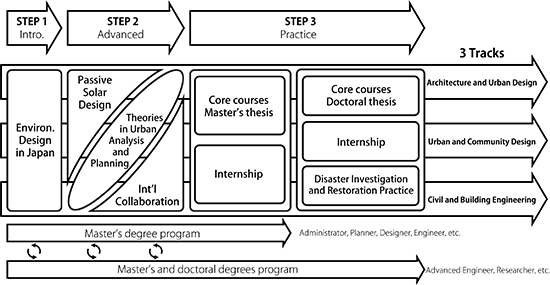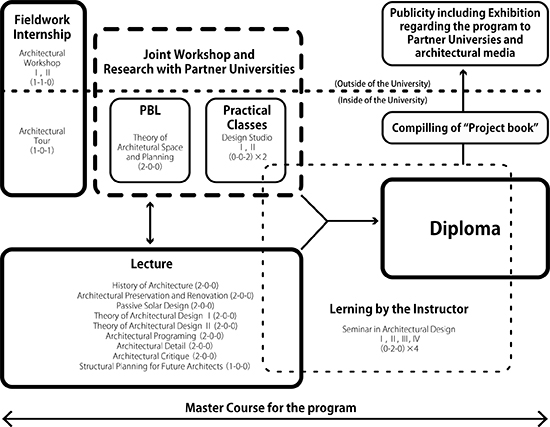
International Graduate Program
Tokyo Institute of Technology (Tokyo Tech)
Department of Architecture and Building Engineering
Core Educational Program: IGP(A) Postgraduate Program for Environmental Designers Contributing to Resilient Cities
The department’s International Graduate Program (A) “The Postgraduate Program for Environmental Designers Contributing to Resilient Cities” is managed in proper collaboration with the department of Civil and Environmental Engineering and offers courses and research opportunities leading to master’s and doctoral degrees.
ATTfN:
Applicants for 2019 Program
*Updated September, 2018
General Information
The present Department of Architecture and Building Engineering was originally launched in 1907 to provide a new course of study in Tokyo Tech’s founding institution, the Tokyo Technical High School (1881). Ours is, therefore, one of the oldest architectural schools in the context of any Japanese university. With its one-hundred-year history it has enjoyed a high reputation both within and outside Japan, with many of its graduates having since become renowned architects, engineers, and scholars.
The departmentfs International Graduate Program (A) is either for masterfs degree only or for both masterfs and doctoral degrees program specially tailored to meet the needs of younger architects and architectural students from abroad. Today the younger generation of students in Europe and the United States, and all other parts of the world, are increasingly interested in the design scene in Japan’s big cities, such as Tokyo\ based on state-of-the-art design backed by advanced building and structural technologies. This special program offers a unique opportunity to delve into such design activities in situ and acquire high-level design skills through exposure to emerging architectural concepts, joint design studios, fieldwork, workshops, and intensive research programs. Japanese students also participate in the program. Working together, students with different cultural backgrounds are stimulated to attain a deeper understanding of innovative design methods and ideas. Note that virtually all lectures and studios, as well as the administration of this program, are in English. This graduate program features various events and environments, including special lectures and project supervision by short-term visiting professors from overseas universities and international exchange workshops in advanced urban and architectural design. IT design-stations, Fab Lab, teaching assistantships for international research students, and exchange of students among universities affiliated with the program also enhance the experience. All features are intended to strengthen the effect of collaborative study and promote exchange between overseas and Japanese students, in the aim of creating a department that will be more global and competitive. We hope our efforts will thus encourage an increasingly robust international network of upcoming leaders: design architects, building engineers, and researchers in allied fields.
Until the recent year our department has regularly offered several places funded by MEXT (Japan Ministry of Education) scholarships, as well as several more non-funded spots to admitted students. Successful applicants will be vetted and selected for these positions based on academic and design achievements submitted by the applicant. For this program, MEXT scholarships has not specified the exact number of places yet.
Particulars of the Program
1) Aims
Architectural activity is today worldwide. It is vital for the present generation to envision a future in broad intercultural terms. In order to foster and encourage architects, engineers, and researchers able to take their part with confidence in a global environment of leading design and technology, our department offers a special International Graduate Program (A) comprising classes, joint design studios, and a number of research workshops for a small international group of students from Japan and overseas. Heightening an awareness of each studentfs cultural background, such resources contribute to enhancing the studentsf abilities, by facilitating a thoroughgoing interaction among classmates and with course instructors. Note that international students can expect careful attention from their academic advisor (see below Item 3) and tutor, as each student will become a full member of that advisorfs own Laboratory or Study Unit (see below Item 5).
2) Academic Degree
The departmentfs International Graduate Program (A) is either for Masterfs degree only or for both Materfs and doctoral degrees. The degrees conferred upon graduation are the Master of Engineering and the Doctor of Engineering. (Note: degrees such as the M. Arch. are almost universally designated within Japan as an engineering degree of the type pursued in this program and are regarded as equivalent.)
3) Application Procedure
Applicants to this International Graduate Program (A) are requested to make contact with an academic advisor in the Department of Architecture and Building Engineering. The names and special fields of the academic advisors qualified to discuss the interests and needs of a potential applicant are listed at the end of this document. In order to reach any one of these advisors, please email the Program Head at <IGP@arch.titech.ac.jp>, who currently oversees the program for the department.
Once the Program Head has suggested a suitable advisor, the applicant is strongly recommended to get in touch by one half month prior to the application deadline at the latest in order to ensure and facilitate the application procedure.
The said applicant is required to submit by the application deadline by postal mail to the Admissions Office of our university the documentation detailed on the application form at the Tokyo Institute of Technology homepage.
If you are not a citizen of a recognized English-speaking country, please note that certification of English proficiency is required in the form of an official English-proficiency score. The test must have been administered within 24 months prior to the application deadline and its score issued by one of five approved testing bureaus: TOEFL-iBT, TOEFL-PBT, TOEFL-CBT, TOEIC or IELTS . (If no score is available, then you should apply for testing at your earliest opportunity. The Admissions Office will admit of no delay in the completion of the application procedure based on late reception of a candidate’s scores. A timely testing date and issuance of one of the above scores is the sole responsibility of the applicant.)
To obtain a required academic advisor's recommendation, the applicant will submit his/her portfolio and a statement of aim for the period of study in Japan written in English, both of which will be carefully evaluated. (If portfolios include collaborative work, applicants should clearly define their role in that project.) Having already completed this evaluation process in advance of the application deadline, the applicant shall submit all required forms by postal mail to the Tokyo Institute of Technology Admissions Office.
The required application document in PDF and WORD-format can be downloaded at the Tokyo Institute of Technology homepage.
Each applicant is strongly encouraged to verify the conditions of eligibility in Item 3: “Eligibility” before actual submission of any application or enquiry.
4) Curriculum
This International Graduate Program (A) is managed in proper collaboration with the department of Civil and Environmental Engineering and offers the special curriculum as shown in Fig.1 below.

Fig.1 Steps and Tracks of the curriculum
The Core Course Curriculum is shown at the end of this document and is conducted essentially in English. A flowchart for the Master’s degree program is also shown in Fig. 2 below.

Fig.2 Flowchart of Master’s degree program
5) Support system for participating students
Each student in this program shall have obtained an academic advisor to facilitate the period of study in Japan. The assigned advisor will offer counsel regarding academic matters, as well as Japanese culture and lifestyle, as required. A sub-advisor, or tutor, will also be ready to assist each student on a daily basis within the advisor’s Study Unit, or Laboratory, where each student will be assigned a dedicated workspace.
Department of Architecture and Building Engineering
Architecture and Urban Design
Professors:
FUJII, Haruyuki, D. Eng. |
Design Science, Architectural Planning and Environmental Design Theories |
OKUYAMA, Shin-ichi, D. Eng. |
Architectural Design |
TSUKAMOTO, Yoshiharu, D. Eng. |
Architectural Design and Urban Research |
YASUDA, Koichi, Ph. D. |
Architectural Design |
Associate Professors:
| FUJITA, Yasuhito, D. Eng. | History of Architecture and Cities |
MURATA, Ryo, D. Eng. |
Architectural Design, Passive Solar Design |
NASU, Satoshi, D. Eng. |
Architectural Design and Theory Public Space and Community Design |
SHIOZAKI Taishin, D. Eng. |
Architectural Design |
YAMAZAKI Taisuke, D. Eng. |
History of Architecture, Architectural Design |
Urban and Community Design
Professors:
| NAKAI, Norihiro, D. Eng. | Urban Planning, Urban Policy, Urban Design |
NAKAMURA, Yoshiki, D. Eng. |
Visual Environment |
OSARAGI, Toshihiro, D. Eng. |
Spatial Analysis and Planning, Disaster Mitigation Planning, Spatial Information Science |
Associate Professors:
| ASAWA, Takashi, D. Eng. | Urban and Built Environmental Engineering |
DOHI, Masato, D. Eng. |
Community Planning and Design |
KAGI, Naoki, D. Eng. |
Environmental Engineering Air Quality |
MANO, Yosuke, D. Eng. |
Urban Planning |
OHKAZE, Tsubasa, D. Eng. |
Urban Environmental Engineering, Snow Engineering, Disaster Resilience for Architectural and Urban Environment |
SAIO, Naoko, D. Eng. |
Architectural Planning, Urban and Rural Planning |
SOSHIRODA, Akira, D. Eng.@ |
Tourism Planning |
YUASA, Kazuhiro, D. Eng. |
Environmental Engineering, Building Services |
Architecture and Urban Design
Professors:
| IKARASHI, Kikuo, D. Eng. | Steel Structures |
KONO, Susumu, D. Eng. |
Reinforced and Prestressed Concrete Structures, Earthquake Engineering |
MATSUOKA, Masashi, D. Eng. |
Remote Sensing and Geoinformatics for Disaster Management |
MOTOYUI, Shojiro, D. Eng. |
Structural Engineering |
SAKATA, Hiroyasu, D. Eng. |
Concrete Structure, Timber Structure |
TAKEUCHI, Toru, D. Eng. |
Steel Structure, Structural Design, Seismic Control |
YAMADA, Satoshi, D. Eng. |
Structural Engineering, Earthquake Engineering |
YAMANAKA, Hiroaki, D. Eng. |
Environmental and Engineering Geophysics, |
YOKOYAMA, Yutaka, D. Eng.@ |
Building Materials |
Associate Professors:
| HOTTA, Hisato, D. Eng. | Composite Structures |
KISHIKI, Shoichi, D. Eng. |
Base]Isolation and Passive Control Structure, Seismic Retrofit for Existing Buildings, Post]Earthquake Damage Evaluation and Rehabilitation |
MIKAMI, Takamasa, D. Eng. |
Performance Evaluation of Building Elements Safety Evaluation of Residential Environment |
NISHIMURA, Koshiro, D. Eng. |
Building structures, Seismic engineering, Concrete structures, Disaster mitigation |
SATO, Daiki, D. Eng. |
Structural Engineering, |
TAMURA, Shuji, D. Eng. |
Geotechnical Earthquake Engineering |
Program Head and contact: < IGP@arch.titech.ac.jp >
Curriculum of the Program
1. Course List
The study guide for the International Graduate Program is shown in Tokyo Tech’s web site below according to each Graduate majors.
Graduate Major in Architecture and Building Engineering:
https://www.titech.ac.jp/guide/guide_30/English_S/pdf/27.pdf
Graduate Major in Urban Design and Built Environment:
https://www.titech.ac.jp/guide/guide_30/English_S/pdf/36.pdf
Graduate Major in Engineering Sciences and Design:
https://www.titech.ac.jp/guide/guide_30/English_S/pdf/32.pdfh
2. Course Details
The all syllabuses are referred in Tokyo Tech’s web site “OCW” below.
TOKYO TECH OCW (OPEN COURSEWARE):
http://www.ocw.titech.ac.jp/index.php?lang=EN
